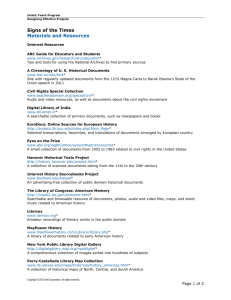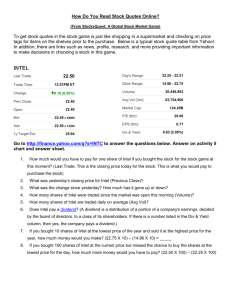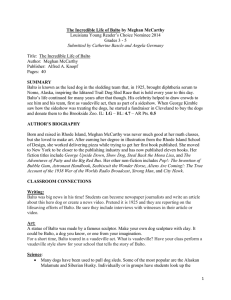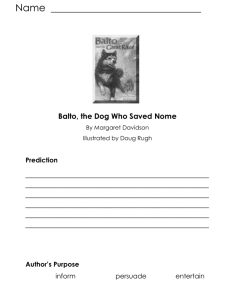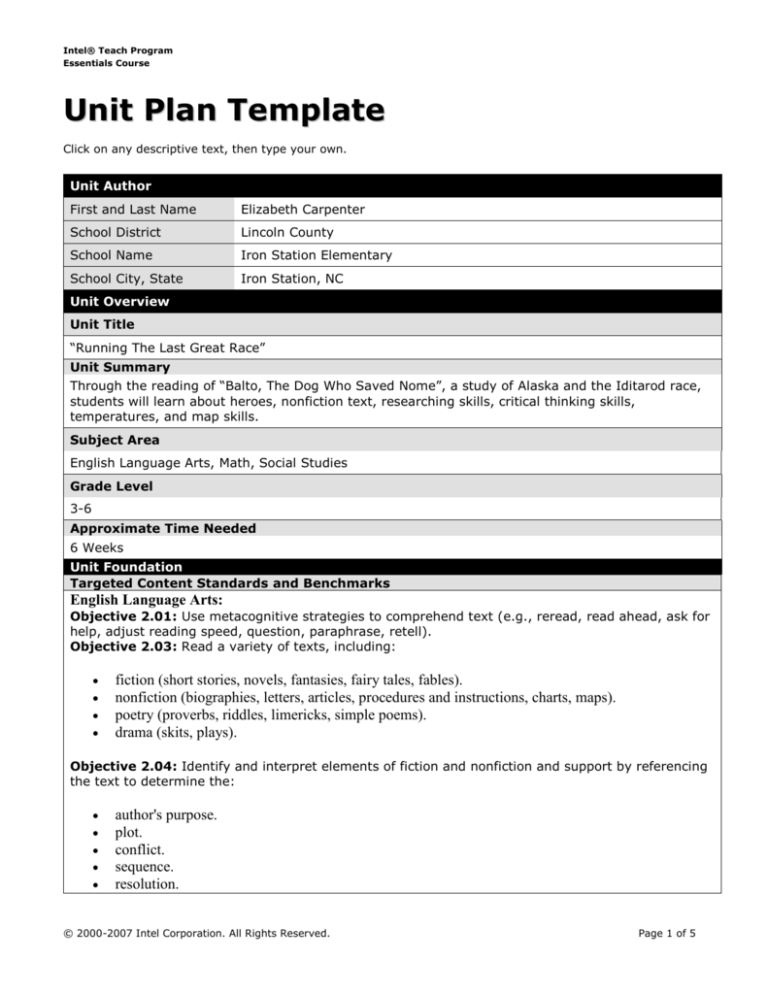
Intel® Teach Program
Essentials Course
Unit Plan Template
Click on any descriptive text, then type your own.
Unit Author
First and Last Name
Elizabeth Carpenter
School District
Lincoln County
School Name
Iron Station Elementary
School City, State
Iron Station, NC
Unit Overview
Unit Title
“Running The Last Great Race”
Unit Summary
Through the reading of “Balto, The Dog Who Saved Nome”, a study of Alaska and the Iditarod race,
students will learn about heroes, nonfiction text, researching skills, critical thinking skills,
temperatures, and map skills.
Subject Area
English Language Arts, Math, Social Studies
Grade Level
3-6
Approximate Time Needed
6 Weeks
Unit Foundation
Targeted Content Standards and Benchmarks
English Language Arts:
Objective 2.01: Use metacognitive strategies to comprehend text (e.g., reread, read ahead, ask for
help, adjust reading speed, question, paraphrase, retell).
Objective 2.03: Read a variety of texts, including:
fiction (short stories, novels, fantasies, fairy tales, fables).
nonfiction (biographies, letters, articles, procedures and instructions, charts, maps).
poetry (proverbs, riddles, limericks, simple poems).
drama (skits, plays).
Objective 2.04: Identify and interpret elements of fiction and nonfiction and support by referencing
the text to determine the:
author's purpose.
plot.
conflict.
sequence.
resolution.
© 2000-2007 Intel Corporation. All Rights Reserved.
Page 1 of 5
Intel® Teach Program
Essentials Course
lesson and/or message.
main idea and supporting details.
cause and effect.
fact and opinion.
point of view (author and character).
author's use of figurative language (e.g., simile, metaphor, imagery).
Objective 3.01: Respond to fiction, nonfiction, poetry, and drama using interpretive, critical, and
evaluative processes by:
considering the differences among genres.
relating plot, setting, and characters to own experiences and ideas.
considering main character's point of view.
participating in creative interpretations.
making inferences and drawing conclusions about characters and events.
reflecting on learning, gaining new insights, and identifying areas for further study.
Objective 4.02: Use oral and written language to:
present information in a sequenced, logical manner.
discuss.
sustain conversation on a topic.
share information and ideas.
recount or narrate.
answer open-ended questions.
report information on a topic.
explain own learning.
Math:
Objective 1.06: Develop flexibility in solving problems by selecting strategies and using mental
computation, estimation, calculators or computers, and paper and pencil.
Objective 2.02: Estimate and measure using appropriate units. - Temperature (Fahrenheit,
Celsius).
Objective 4.01: Collect, organize, analyze, and display data (including circle graphs and tables) to
solve problems.
Social Studies:
Objective 4.02: Use appropriate source maps to locate communities.
Objective 4.04: Compare how people in different communities adapt to or modify the physical
environment to meet their needs.
Student Objectives/Learning Outcomes
Students will:
Use comprehension strategies to read nonfiction and fiction text regarding the Iditarod and
Alaska
Develop connections within the texts and themselves
© 2000-2007 Intel Corporation. All Rights Reserved.
Page 2 of 5
Intel® Teach Program
Essentials Course
Identify and interpret literary elements within the text
Respond to literature orally and in written form
Develop problem solving skills
Identify the appropriate temperature based on conditions
Use a spreadsheet to collect, sort, and display data
Locate Alaska and the communities on the map, as well as track the race
Compare and contrast the Alaskan communities with our community
Curriculum-Framing Questions
Essential
Can you finish the race?
Question
Unit
Questions
Content
Questions
What can Balto teach us about life?
How would you run the Iditarod?
How is a community in Alaska like your community?
Make a bar graph using the temperatures that you have gathered from
the cities in Alaska.
Assessment Plan
Assessment Timeline
Before project work begins
Questioning
KWL
Students work on projects
and complete tasks
Teacher
Conferencing
Journal
Checklist
Teacher
Monitoring
Graphic
Organizers
Peer Feedback
After project work is
completed
Project
Scoring
Guide
Self
Assessment
Checklist
Formative
Assessment
Assessment Summary
Students will be assessed throughout the unit by constant teacher monitoring and teacher
conferencing. I will use journals, blogs, and wikis to assess the students understanding of the
content and the connections that they have made to the unit. During our reading of Balto, The Dog
Who Saved Nome, students will be questioned daily and will have a formative assessment at the end.
Students will also be assessed by using various graphic organizers and Google Docs throughout our
study.
Unit Details
© 2000-2007 Intel Corporation. All Rights Reserved.
Page 3 of 5
Intel® Teach Program
Essentials Course
Prerequisite Skills
Internet research skills, Basic typing skills
Instructional Procedures
After planning and teacher conferencing, students will complete a Wiki responding to: Write
about a day when you are running the Iditarod race.
Students will respond to questions on a blog that have been posted on the blog by the teacher
and/or students that pertain to the reading and unit.
Students will research a community in Alaska that the Iditarod race travels through and
create a flyer using the template given by the teacher.
Students will research and monitor their musher’s’ progress through the Internet and Google
Docs.
Using the research on the student’s mushers, the students will complete a PowerPoint
presentation about their mushers.
As a class, we will collect the temperatures at the checkpoints as the mushers arrive. Then,
in small groups, the students will complete an Excel spreadsheet and a bar graph displaying
this information.
Students will complete the Balto Reading Comprehension booklet using Balto, The Dog Who
Saved Nome and their Dogsledding Guide
Accommodations for Differentiated Instruction
Resource
Student
Graphic organizers to help students organize research and thoughts, material will be
read aloud at appropriate times, extended time will be given to complete the
products, students will be assigned a peer helper to assist with answering blog
questions, modify assignments
Nonnative
English
Speaker
Graphic organizers to help students organize research and thoughts, extended time
will be given to complete the products, dual dictionary will be provided for
assistance, students will work in groups to complete projects, modify assignments
Gifted
Student
Critical thinking activities will be given to expand the students’ learning, Contract
given to students to choose projects, Centers
Materials and Resources Required For Unit
Technology – Hardware (Click boxes of all equipment needed)
Camera
Laser Disk
VCR
Computer(s)
Printer
Video Camera
Digital Camera
Projection System
Video Conferencing Equip.
DVD Player
Scanner
Other
Internet Connection
Television
Technology – Software (Click boxes of all software needed.)
Database/Spreadsheet
Image Processing
Web Page Development
Desktop Publishing
Internet Web Browser
Word Processing
E-mail Software
Multimedia
Other
Encyclopedia on CD-ROM
© 2000-2007 Intel Corporation. All Rights Reserved.
Page 4 of 5
Intel® Teach Program
Essentials Course
Printed Materials
Balto, The Dog Who Saved Nome, Balto Comprehension Booklet,
Dogsledding Guide
Supplies
Flash drives or disks to save student information on
Internet Resources
Other Resources
www.iditarod.com
http://teacher.scholastic.com/activities/iditarod/
http://www.cabelasiditarod.com/
http://education.nmsu.edu/webquest/wq/iditarod/
Virtual Field Trip to Alaska
Programs of the Intel® Education Initiative are funded by the Intel Foundation and Intel Corporation.
Copyright © 2007, Intel Corporation. All rights reserved. Intel, the Intel logo, Intel Education Initiative, and Intel Teach Program are
trademarks of Intel Corporation in the U.S. and other countries. *Other names and brands may be claimed as the property of others.
© 2000-2007 Intel Corporation. All Rights Reserved.
Page 5 of 5



